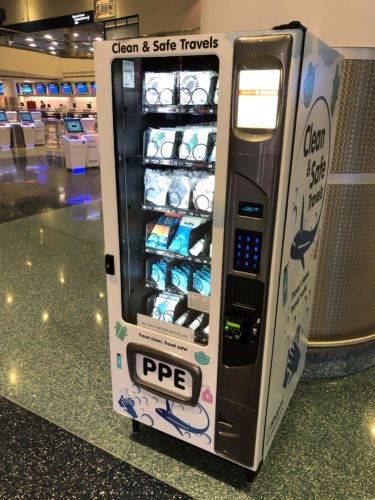Airports are joining airlines in ramping up service and welcoming passengers back to terminals that have been all but empty for months due to a record coronavirus-induced drop in air traffic.
And, like the airlines, most every airport is going all out to proclaim extreme vigilance in keeping facilities clean and travelers safe.
Mask required for all passengers entering the terminals? Yes at airports in Los Angeles, Chicago, Miami, Denver, Seattle, Portland, San Francisco, New York, Washington, D.C. and in many other cities. Airports in some other cities, such as Charlotte, recommend face masks be worn in the terminals although most airlines now require passengers wear masks from the curb to – and onto – the planes.
Don’t have a mask? Airports will have them for you.
The Federal Government is in the process of distributing more than 86 million masks to airports. Hartsfield-Jackson Atlanta International Airport (ATL) now has a stash of 4.7 million masks for distribution. Seattle-Tacoma International Airport (SEA) has 2.5 million masks ready to hand out.
Floor decals marking six-foot lengths to encourage social distancing? Check.
Harrisburg International Airport (MDT), not far from Hershey, PA, reminds travelers to stay 6 feet or 72 KISSES chocolates away from other passengers.
Upgraded and robust cleaning protocols? Check. Airport employees – and in some cases, robots, such as the autonomous robotic floor scrubbers at Pittsburgh International Airport – are wiping, washing, spraying and sanitizing at every turn.
Oodles of hand sanitizing stations? Check. Some airports have added hundreds of sanitizer dispensers and, like Seattle-Tacoma International Airport (SEA), now note the dispenser locations on maps and apps.
Plexiglass barriers at check-in counters, security checkpoints and gates? Check.
Step stools to make it easy for kids (and short people) to wash their hands in airport bathrooms? Check. More than 200 airports (and counting) now have Step ‘n Wash devices in the restrooms.
Shops and vending machines selling personal protective equipment? Check.

Many airport shops now stock PPE supplies and PPE vending machines are installed at McCarran International Airport in Las Vegas and at Denver International Airport. Hudson just announced plans to roll out PPE vending machines at 27 major airports in North America.
Branded plans and promises
Like the airlines, airports are also rolling out branded plans to underscore their commitment to cleanliness and passenger safety.
The Houston Airport’s “FlySafeHouston” program includes adding facial comparison technology at 15 gates by October and UV disinfecting cuffs for escalators, among other measures.
At Louis Armstrong New Orleans International Airport it’s the “MSY Travel Ready” plan. Los Angeles International Airport (LAX) has a Travel Safely at LAX plan. Jacksonville International Airport has its JAX Airport Cares program. And at Miami International Airport, it’s #MIACares.”
In many cases airport COVID-19 response plans highlight new technology and bonus efforts being made.
For example, the “Traveler Confidence Plan” at Ted Stevens Anchorage International Airport notes that the main escalators have “newly installed UV-C handrail sterilization modules” and that the airport has new high-capacity floor cleaners.
The #ReadySetROC initiative at the Greater Rochester International Airport (ROC) in New York promises that enhanced cleaning includes a regular misting of anti-bacterial cleaner/solution on seating and surfaces.
At McCarran International Airport in Las Vegas, which installed the country’s first vending machine filled with personal protective equipment (PPE), the campaign is dubbed “LAS All In,” and includes Vegas-themed slogans such as “Don’t roll the dice: Stay 6 ft apart!” and “We’re doubling down on cleaning and sanitizing.”
TSA has new safety protocols too
This summer travelers will also encounter some new protocols at most every airport security checkpoint in response to the COVID-19 pandemic.
The Transportation Security Administration’s updated security procedures now allow travelers to carry up to 12 ounces of hand sanitizer in carry-on bags, but require those containers to be screened separately. Passengers may also wear their face masks during the TSA screening process but should be ready to lower or adjust the mask for an identity check.
To avoid having TSA officers touch passengers’ paper boarding passes or mobile devices, TSA will ask all passengers to scan their own boarding pass and hold it up for a TSA officer to do a visual check.
And TSA now asks that any food packed in carry-on bags to removed and scanned separately. So to avoid having your food contaminated in a bin or on the belt, be sure to pack it inside a clear plastic bag.
Thanks for visiting Stuck at the Airport. Subscribe to get daily travel tidbits. And follow me on Twitter at @hbaskas and Instagram.